
Measuring Area and Perimeter using US Customary and Metric units - Mathematics Instructional Plan
- Subject:
- Mathematics
- Material Type:
- Lesson Plan
- Provider:
- VDOE
- Author:
- VDOE
- Date Added:
- 10/07/2024

Measuring Area and Perimeter using US Customary and Metric units - Mathematics Instructional Plan

Measuring Surface Area - Mathematics Instructional Plan

Will the Tablecloth Fit? Mathematics Instructional Plan

Estimate and find area of polygons - Algebra Readiness Remediation Plan

Differentiate among perimeter, area, and volume; Identify which concept is appropriate for a given situation - Algebra Readiness Remediation Plan

Differentiating among area, perimeter, and volume; solving practical problems - Mathematics Instructional Plan

Apply concept of perimeter, area, or volume - Algebra Readiness Remediation Plan

The student will complete a task where they are given 50 feet of fencing. They have to design the largest area of garden using all of the fencing. Students must explore circles, right triangles, and rectangles. Students will be using the formulas of area and perimeter and circumference to calculate perimeter and area. This task was created with Jamboard to allow students to collaborate together in person or remotely, in real time, as well as allowing the teacher to view students' work in progress. The initial slide presents the task and provides the formulas for each shape’s area and perimeter. The subsequent slides provide workspace for students’ thinking and collaboration. The last slide is a conclusion slide. Here students tell which shape they chose, give the measurements, and justification

Designing a Dog Park Task Template, Student Version of Task, Anchor Pages and Scoring Rationale

Practical Problems Involving Area and Perimeter Mathematics Instructional Plan

Composite Figures Mathematics Instructional Plan
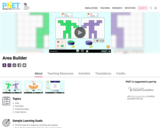
Create your own shapes using colorful blocks and explore the relationship between perimeter and area. Compare the area and perimeter of two shapes side-by-side. Challenge yourself in the game screen to build shapes or find the area of funky figures. Try to collect lots of stars!
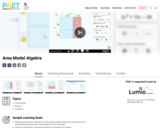
Build rectangles of various sizes and relate multiplication to area. Discover new strategies for multiplying algebraic expressions. Use the game screen to test your multiplication and factoring skills!

Build rectangles of various sizes and relate multiplication to area. Partition a rectangle into two areas to discover the distributive property.
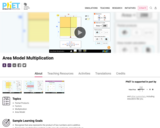
Build rectangles of various sizes and relate multiplication to area. Discover new strategies for multiplying large numbers. Use the game screen to test your problem solving strategies!
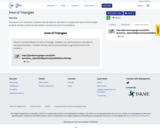
This lesson is on Jamboard. Students will use Desmos calculator to compute the area of the triangles. Students will also use the formula sheet to use the formula for the problems.

Students will be shown different layouts of hotel rooms and be given a survey about which one was their favorite. The students will interpret the data to try to explain why certain rooms were more favorable than others. Students will then be given graph paper and asked to design their own hotel room. Students will determine the area and perimeter of the objects in their hotel rooms. Lastly, students will be shown the actual area and perimeter of hotel room items to compare to the ones that they created.
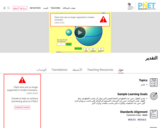
Explore size estimation in one, two and three dimensions! Multiple levels of difficulty allow for progressive skill improvement.

In Unit 4, students understand area as how much two-dimensional space a figure takes up and relate it to their work with multiplication in Units 2 and 3.
In early elementary grades, students may have informally compared area, seeing which of two figures takes up more space. In Grade 2, students, partitioned a rectangle into rows and columns of same-sized squares and counted to find the total number of them, including skip-counting and repeated addition to more efficiently do so (2.G.2, 2.OA.4).
Students begin their work in this unit by developing an understanding of area as an attribute of plane figures (3.MD.5) and measure it by counting unit squares (3.MD.6). After extensive work to develop students’ spatial structuring, students connect area to the operation of multiplication of length and width of the figure (3.MD.7a, b). Lastly, students connect the measure of area to both multiplication and area, seeing with concrete cases that the area of a rectangle with whole-number side lengths a and b+c is the sum of a×b and a×c (3.MD.7c), and using the more general idea that area is additive to find the area of composite figures (3.MD.7d). Thus, the unit serves as a way to link topics and thinking across units, providing coherence between the work with multiplication and division in Units 2 and 3 (3.OA) with the work of area in this unit (3.MD.C).
Students will engage with many mathematical practices deeply in the unit. For example, students “use strategies for finding products and quotients that are based on the properties of operations; for example, to find [the area of a rectangle by multiplying] 4×7, they may recognize that 7=5+2 and compute 4×5+4×2. This is an example of seeing and making use of structure (MP.7). Such reasoning processes amount to brief arguments that students may construct and critique (MP.3)” (PARCC Model Content Frameworks for Mathetmatics, p. 16). Further, students make use of physical tiles, rulers to relate side lengths to physical tiles, and later in the unit, the properties of operations themselves in order to find the area of a rectangle (MP.5). Additionally, “to build from spatial structuring to understanding the number of area-units as the product of number of units in a row and number of rows, students might draw rectangular arrays of squares and learn to determine the number of squares in each row with increasingly sophisticated strategies, such as skip-counting the number in each row and eventually multiplying the number in each row by the number of rows (MP.8)” (GM Progression, p. 17).

In Unit 5, students explore concepts of perimeter and geometry. Students have gradually built their understanding of geometric concepts since Kindergarten, when students learn to name shapes regardless of size and orientation. They also learn to distinguish between flat and solid shapes. In Grade 1, students’ understanding grows more nuanced, as they learn to distinguish between defining and non-defining attributes, as well as compose and decompose both flat and solid shapes. In Grade 2, students draw and identify shapes with specific attributes. All of this understanding gets them ready for Grade 3, in which students begin their journey of measuring those attributes, including area (addressed in Unit 4), and perimeter (explored here), as well as classification of shapes based on attributes into one or more categories.
Students begin the unit by defining perimeter as the boundary of a two-dimensional shape and measure it by finding its length. For a polygon, the length of the perimeter is the sum of the lengths of the sides. They develop their understanding of perimeter by measuring it with a ruler, finding it when all side lengths are labeled, and then finding it when some information about the length of a shape’s side lengths needs to be deduced, such as when a rectangle only has its length and width labeled. Students then solve real-world and mathematical problems, both given a figure and without one, involving perimeters of polygons (3.MD.8). With this understanding of perimeter, they are able to compare the measurement of area and perimeter of a rectangle, seeing that a rectangle with a certain area can have a variety of perimeters and, conversely, a rectangle with a certain perimeter can have a variety of areas, connecting the additional cluster content of perimeter to the major cluster content of area. Students then solve various problems involving area and perimeter. The last topic of the unit explores geometry. Students build on Grade 2 ideas about polygons and their properties, specifically developing and expanding their knowledge of quadrilaterals. They explore the attributes of quadrilaterals and classify examples into various categories (3.G.1), then explore attributes of polygons and classify examples into various categories, now including quadrilaterals. Students also draw polygons based on their attributes. Students next use tetrominoes and tangrams to compose and decompose shapes.
In this unit, students reason abstractly and quantitatively, translating back and forth between figures and equations in the context of perimeter problems (MP.2). Students will also construct viable arguments and critique the reasoning of others as they develop a nuanced understanding of the difference between area and perimeter, as well as when they classify shapes according to their attributes and justify their rationale (MP.3). Lastly, students will use appropriate tools strategically by using rulers to measure the side lengths of polygons to find their perimeter, as well as use rulers and right angle templates to find attributes of shapes to determine their classification (MP.5).